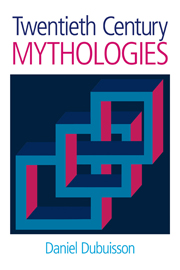Book contents
- Frontmatter
- Epigraph
- Contents
- Foreword by Professor Robert A. Segal
- Preface
- Abbreviations
- Introduction: History and comparative epistemology
- Part I Georges Dumézil, or Society
- 1 The Indo-European background
- 2 The first comparative mythologies
- 3 Durkheim, Mauss, Bourdieu, and Dumézil
- 4 The 1950s: a reorientation
- 5 Comparative and structural evidence
- 6 The new comparative mythology
- Addendum I Theory, history, and the limits of Dumézil's comparativism
- Addendum II Does a Dumézilian theory of religion exist?
- Part II Claude Lévi-Strauss, or the Mind
- Part III Mircea Eliade, or the Sacred
- Conclusion: Modern theories of myth and the history of Western thought
- Bibliography
- Index
Addendum II - Does a Dumézilian theory of religion exist?
from Part I - Georges Dumézil, or Society
- Frontmatter
- Epigraph
- Contents
- Foreword by Professor Robert A. Segal
- Preface
- Abbreviations
- Introduction: History and comparative epistemology
- Part I Georges Dumézil, or Society
- 1 The Indo-European background
- 2 The first comparative mythologies
- 3 Durkheim, Mauss, Bourdieu, and Dumézil
- 4 The 1950s: a reorientation
- 5 Comparative and structural evidence
- 6 The new comparative mythology
- Addendum I Theory, history, and the limits of Dumézil's comparativism
- Addendum II Does a Dumézilian theory of religion exist?
- Part II Claude Lévi-Strauss, or the Mind
- Part III Mircea Eliade, or the Sacred
- Conclusion: Modern theories of myth and the history of Western thought
- Bibliography
- Index
Summary
Before answering this question, another one should first be asked: how does the work of a specialist in Indo-European comparative mythology draw attention to the most general problematic that can be formulated by the history of religions as a historical and anthropological discipline? To answer this question one must of course re-examine the history of mythological studies since the seventeenth century in order to understand how this subsequently inseparable myth-religion couple was formed. It is beyond doubt, at least, that from the end of the eighteenth century, as we see from Court de Gébelin, the idea was asserted that myths corresponded and referred to the most primitive forms of religion. This idea would be taken up again by anthropologists and historians of religions at the end of the nineteenth century – for example, Edward Burnett Tylor and Andrew Lang – with a conviction commensurate with the fact that it admirably suited their vast evolutionist perspective; the absurd, baroque, or excessive myths of primitive tribes discovered then had to resemble those of distant human ancestors. In addition we must remember that, if the contemporaries of Tylor and Lang accorded such a central place to the myths, it was also because, nourished with classical texts, as were their predecessors of the seventeenth (Bacon) and eighteenth centuries (Joseph Lafiteau, Charles de Brosses, Jacques Dupuis, Georg Creuzer), they adopted the exegetical and interpretive methods elaborated by antiquity (euhemerism; naturalist, moral, or metaphysical allegories) in order to explain Homeric texts.
- Type
- Chapter
- Information
- Twentieth Century Mythologies , pp. 93 - 102Publisher: Acumen PublishingPrint publication year: 2006



